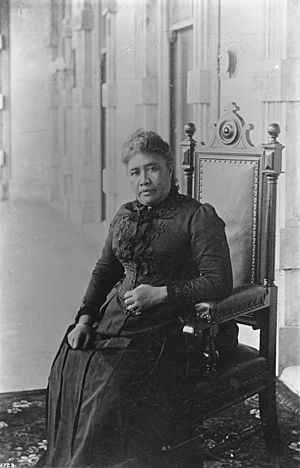Liliʻuokalani's Cabinet Ministers facts for kids
Liliʻuokalani was the first and only queen to rule the Hawaiian Kingdom. She was also the last ruler of Hawaiʻi before it became a territory of the United States. Queen Liliʻuokalani became queen on January 29, 1891. This was just nine days after her brother, King Kalākaua, passed away. She took over his government, which included four main ministers. These were the Attorney General, Minister of Finance, Minister of Foreign Affairs, and Minister of the Interior. These ministers were also part of the legislature and a larger group of advisors called the Privy Council.
King Kalākaua had been forced to sign a new set of rules in 1887, known as the Bayonet Constitution. This constitution allowed the monarch to choose ministers. However, only the legislature could remove them. If the legislature voted "no confidence," all the ministers had to resign. This new law also changed who could vote. It allowed people who didn't live in Hawaiʻi to vote. But it made it harder for most Native Hawaiians and Asians to vote. After her brother's funeral, Queen Liliʻuokalani asked his ministers to resign. They refused, which led to a legal challenge. The Supreme Court of Hawaiʻi decided in her favor.
Soon after she became queen, Liliʻuokalani started getting requests. Groups like Hui Kālaiʻāina and the National Reform Party wanted to change the constitution. The queen worked with two lawmakers, Joseph Nāwahī and William Pūnohu White, to write a new constitution. This new plan would have given more power back to the monarchy. It also would have given voting rights back to the people who had lost them.
On January 13, 1893, Queen Liliʻuokalani chose new ministers. These were Attorney General Arthur P. Peterson, Minister of Finance William H. Cornwell, Minister of Foreign Affairs Samuel Parker, and Minister of the Interior John F. Colburn. She picked them because she thought they would support her new constitution. However, they refused to sign the document. Just four days later, on January 17, 1893, the Kingdom of Hawaiʻi was overthrown. This was a sudden takeover planned by the Committee of Safety. This group was mostly made up of foreign residents in Honolulu. Their main goal was for the United States to take over Hawaiʻi.
Contents
Understanding the Queen's Government
The queen's government had important roles, similar to a president's cabinet today. These ministers helped run the country. They were involved in law, money, foreign relations, and managing the country's internal affairs.
Key Ministers and Their Roles
Queen Liliʻuokalani worked with many different ministers during her time as queen. Some ministers served for short periods, while others were involved in major events.
- Attorney General: This minister was the chief legal advisor to the queen and the government. They made sure laws were followed.
- Minister of Finance: This person managed the kingdom's money. They handled taxes, budgets, and trade.
- Minister of Foreign Affairs: This minister dealt with other countries. They handled treaties and relationships with nations like the United States.
- Minister of the Interior: This minister managed the internal affairs of the kingdom. This included things like land, public works, and local communities.
Challenges with the Cabinet
The Bayonet Constitution made it hard for the queen to choose her own team. Even if she appointed ministers, the legislature could remove them. This led to many changes in her cabinet. Sometimes, a "resolution of want of confidence" would force a whole group of ministers to resign. This happened several times during her rule.
For example, on January 12, 1893, a group of ministers known as the Wilcox cabinet was removed. The very next day, the queen appointed a new cabinet. However, these new ministers, including John F. Colburn, William H. Cornwell, Samuel Parker, and Arthur P. Peterson, refused to support her new constitution. This refusal was a key event leading to the overthrow of the kingdom.
Images for kids





















